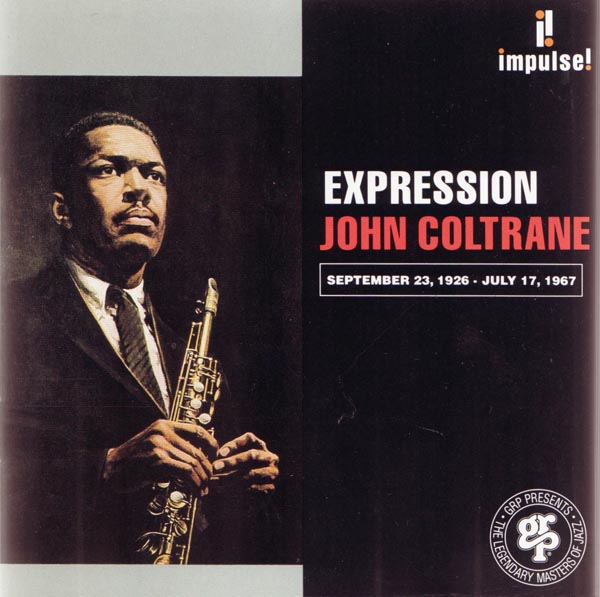JOHN COLTRANE


1/ Ogunde (J. Coltrane) 3.36
2/ To Be (J. Coltrane) 16.20
3/ Offering (J. Coltrane) 8.25
4/ Expression (J. Coltrane) 10.50
5/ Number One (J. Coltrane) 11.55
Recorded at the Van Gelder Studio, Englewood Cliffs New Jersey 1967
Engineered by Rudy Van Gelder
Produced by Bob Thiele and John Coltrane
Reissue produced by Michael Cuscuna
Digitally Remastered by Paul Elmore
John Coltrane: soprano saxophone, tenor saxophone, flute (2); Pharoah Sanders: piccolo, flute, tambourine (2); Alice Coltrane: piano; Jimmy
Garrison: bass; Rashied Ali: drums.
1967 - Impulse! Records (USA), AS-9120 (Vinyl)
1993 - Impulse! Records (USA), GRD-131 (CD)
Note: Track 5 does not appear on the original release, having originally been included on the album 'Jupiter Variations'.
The first work on the disc is called Ogunde- when I first switched the album on, I was taken aback (in a good way, though) by the direct emotion and lyricism. It is one of my favourite moments from this CD. After that, Coltrane picks up a flute and plays for 16 minutes on To Be. There are quite a few interesting passages, such as a mysterious, Oriental-sounding opening, and, even if I can see the point of one reviewer who called it 'over-long', I think that it does definetly work. Track 3 is Offering, which opens, like all of the tracks but Number One, lyricaly. The title seems appropriate, with the majestic opening, and impassioned soloing of Coltrane throughout. Now for the fourth piece, and my favourite, the sublime Expression. The opening is absolutely glorious, with a timeless feel about it that pervades all 10 minutes and 50 seconds of the piece. The music then slides seamlessly into a faster, passionate, restlesss, section, with some good soloing from Alice Coltrane, whose piano-playing, especially in her solo moments, really impressed me. Coltrane re-enters, with a honking, crying, swaying, almost shrieking display of (by no means empty) pyrotechnics, before, magically, the original melody seeps back in, until the pyrotechnics fade away and we are left with the calm, moving beauty of the opening. I have already expressed my feeling about Track 5, and, in my opinion, the less said about it the better.
To sum up, I would recommend this album to anyone who is a bit adventurous-don't come expecting anything traditional by any means: prepare to be surprised, maybe even shocked, but, if you can stomach it, you will find immense rewards in store. Maybe I should leave the last word to the liner notes: 'The music lives so completely, so strongly, so organically on its own terms that it speaks directly to anyone open enough to hear.'
DMG (courtesy of Amazon.com website)
When he died on July 17, 1967, John Coltrane was in a period of exploration, and while his musical pedigree afforded him a level of jazz authenticity that perennial outsiders such as Albert Ayler, Ornette Coleman, and Cecil Taylor could only dream of, the cathartic, rhythmically turbulent music of 1965-1967 tested the indulgence and endurance of even his staunchest fans. But Coltrane was a creative lightning rod for any number of improvisors, and while a few jazzmen, such as the Art Ensemble of Chicago and Julius Hemphill, followed his spiritual lead, his vertical constructs and open-ended modality also found fruition in the open-ended, electric blues and jazz of groups such as Cream, the Jimi Hendrix Experience, the Mahavishnu Orchestra, and the many bands of Trane's old mentor Miles Davis. "Ogunde" is an ecstatic, rolling ballad, all white-peaked waves and billowing winds, in the lyric tradition of A Love Supreme. Likewise, on "Offering," the centerpiece of Expression, Trane proceeds from a stirring lyric prelude, through spasmodic rhythmic abstractions, culminating in a jubilant, wailing dialogue with the droning, pulsating percussion of Rashied Ali.
Chip Stern (courtesy of Amazon.com website)
This music came from John Coltrane's final recording sessions, although no one at that time knew it. It was emblematic of his work in that era — unpredictable, experimental, restless, sometimes remarkable, sometimes more noteworthy for what was being attempted than presented. GRP's recently reissued CD includes a great bonus cut, the nearly 12-minute "Number One" with surging, raw Coltrane tenor contrasted by Pharoah Sanders' piccolo and flute. But while the new material was valuable, the compelling cut here remains "To Be," the 16-minute-plus Coltrane/Sanders dialogue on flutes and piccolo. It was the only time on record that Coltrane played flute (at least for any lengthy period), and his singing lines, blend of raspy and lyrical phrases and overall approach were as identifiable on that instrument as any of his saxes.
Ron Wynn (courtesy of All Music Guide website)